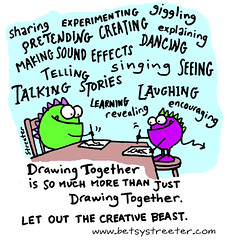 Maybe a lot of my discoveries about kids and drawing have come from my bad classroom management habits.
Maybe a lot of my discoveries about kids and drawing have come from my bad classroom management habits.I do tend to get the kids riled up and making all sorts of random projects. It just happens.
But I have to say, thank goodness for bad classroom management. Because without it, I might not have made these discoveries or started Drooly Dog.
When a kid makes marks - on a piece of paper, or in wet sand or dirt, or even on the freshly-painted wall in the kitchen - there is much more going on than just producing a picture to look at. A window is being opened into another, bigger, world.
Drawing is a process that goes beyond language, and that brings out kinetic, visual, and even auditory activities when the pencil hits the paper (or the crayon hits the wall).
Watch a small child draw. They are moving, they are making sound effects. If something in the picture is supposed to be going fast, the crayon moves fast, too. Sometimes it looks like a dance.
I've been drawing with and for kids (and grownups) for quite a long time. All my life, actually.
When I started taking on the role of "teacher," at first I figured that I should have some cool project the class would do, so at the end we had something to "show." This is good classroom management.
But I quickly found that it was far more interesting, for myself and for the students, to use drawing (or other things, like puppet making) as a medium to have a conversation. Not to make some standard result. Technique was a means to control how you communicated, not something you had to master.
Okay, "interesting" is an understatement. I felt like I had peeked into a whole new world.
My attention shifted away from managing the classroom (though it's still good to observe some decorum and avoid, say fights and injuries) and toward really, really looking at and listening to what was coming out of these kids.
And I found that when I did that, the kids were engaged. Yes, paper airplanes still got thrown and project teams would "invade" each other and things like that, but that engagement was like gold.
And when the parents came to pick them up, I felt I could talk to them about their kids as people, and that we had learned something and expanded the world a little bit. I love showing a parent some unexpected and really deep thing their child has made and saying, your kid came up with this.
Art is a process, art is a state of mind and a state of being. This is especially true for young people.
These days, we really like to measure things with tests and assessments. So I'm going to say this, and keep saying it, and keep saying it:
The arts give our young people the power to bring their own voice to the conversation about who they are and how they think.
We don't ask this when we give them a standardized test. And it is one of the most important things that they will need to explore, and express, in their whole lives.
The Drooly Dog Drawing Project is starting a conversation with young people about their art. It is meant to show this process in action, and give people of all ages the ability to open up this window - and look through it - for themselves.
Join me!
Here's more about the Drooly Dog Drawing Project, where we are headed for big conversations with young people about their art. We're also on Facebook. See you there, and please take part. Change the world.

































